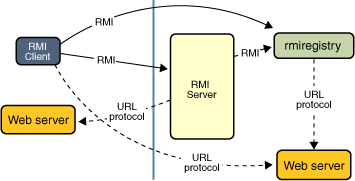An Overview of RMI Applications
RMI applications often comprise two separate programs, a server and a client. A typical server program creates some remote objects, makes references to these objects accessible, and waits for clients to invoke methods on these objects. A typical client program obtains a remote reference to one or more remote objects on a server and then invokes methods on them. RMI provides the mechanism by which the server and the client communicate and pass information back and forth. Such an application is sometimes referred to as a distributed object application.
Distributed object applications need to do the following:
- Locate remote objects. Applications can use various mechanisms to obtain references to remote objects. For example, an application can register its remote objects with RMI's simple naming facility, the RMI registry. Alternatively, an application can pass and return remote object references as part of other remote invocations.
- Communicate with remote objects. Details of communication between remote objects are handled by RMI. To the programmer, remote communication looks similar to regular Java method invocations.
- Load class definitions for objects that are passed around. Because RMI enables objects to be passed back and forth, it provides mechanisms for loading an object's class definitions as well as for transmitting an object's data.
Java object serialization
In Java RMI, both objects and primitive data values may be passed as arguments and results of method invocations. An object is an instance of a Java class. For example, the Java class equivalent to the Person struct defined in CORBA IDL might be:public class Person implements Serializable {
private String name;
private String place;
private int year;
public Person(String aName, String aPlace, int aYear) {
name = aName;
place = aPlace;
year = aYear;
}
// followed by methods for accessing the instance variables
}[book page 162]
In java serialize an object means to convert its state to a byte stream so that the byte stream can be reverted back into a copy of the object. A Java object is serializable if its class or any of its superclasses implements either the java.io.Serializable interface or its subinterface, java.io.Externalizable. Deserialization is the process of converting the serialized form of an object back into a copy of the object.[ref]
Another kind of serialization could be XML & JSON.
SOAP use XML.
Android or javascript ("jquery") use JSON . more information page 164 book.

No comments:
Post a Comment